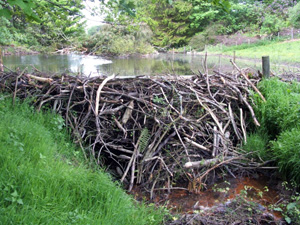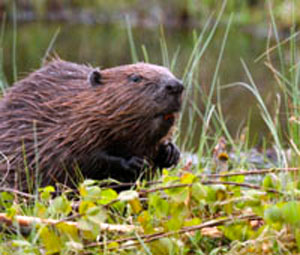Beavers – reducing pollution?

Once upon a time, beavers (Castor fiber) were widespread in the U.K, however, there are few records after the 11th century and by the sixteenth century they were extinct . They are still to be found in Europe; several thousand live on or near the Elbe and the Rhône, and in parts of Scandinavia.
They were hunted to extinction as the animal provided meat, fur and ‘medicine’. The yellow secretion of their anal glands (castoreum) was used, at one time, as an analgesic, anti-inflammatory and antipyretic. The Romans thought that the fumes from burning castoreum could induce an abortion. Medical uses are no longer ‘in vogue’ but castoreum is used in the making of certain perfumes.
In recent times, they have been a number of beaver reintroductions - specifically in the South West and in Scotland. It has been claimed that beaver ‘hydraulic engineering’ in smaller rivers and the headwaters of river systems holds back water during heavy rain and storms, thus reducing the risk of flooding.
However, not everyone is so positive about ‘beaver landscaping’. There have been reports that their dams have blocked drainage ditches in agricultural areas and crops were damaged due to flooding. There were also reports of damage to trees near to roads and the breaching of anti-flood embankments.
Recent research work by Professor Richard Brazier now suggests that beavers are effective in cleaning up agricultural run-off (water rich in soil and nitrates etc.). There are 20 hectares of intensively managed grassland feeding into the beavers’ area (near Okehampton) – these bring manure, slurry and non-organic fertiliser in the run off. The beaver activity (building dams, creation of ponds) filters out much of this material very effectively, like a good reed system. Indeed, the level of sediment coming out of the dams is so low that the levels of nitrogen and phosphate remaining in the water scarcely register in the outflow of their system.
 However, others are less enthusiastic (for example, Professor Jane Rickson [Cranfield University] and are still concerned about beaver activity in terms of reducing the channel of a river, thereby increasing the risk of flooding. There is also the possibility that in areas of poor vegetational cover that they might remove trees and shrubs, thereby exposing soil and increasing erosion. Damage to river banks is also possible.
However, others are less enthusiastic (for example, Professor Jane Rickson [Cranfield University] and are still concerned about beaver activity in terms of reducing the channel of a river, thereby increasing the risk of flooding. There is also the possibility that in areas of poor vegetational cover that they might remove trees and shrubs, thereby exposing soil and increasing erosion. Damage to river banks is also possible.
A common misconception about beavers is that they will eat all the fish in an area; however, beavers are actually herbivores. They prefer the wood of quaking aspen, willow, alder, birch, maple and cherry trees. They also eat sedges, and pondweeds.
Comments are closed for this post.
